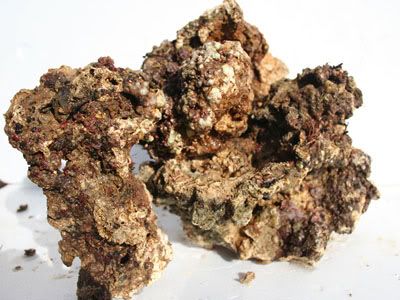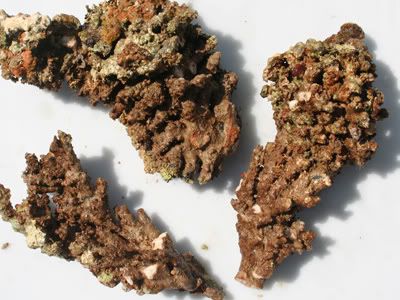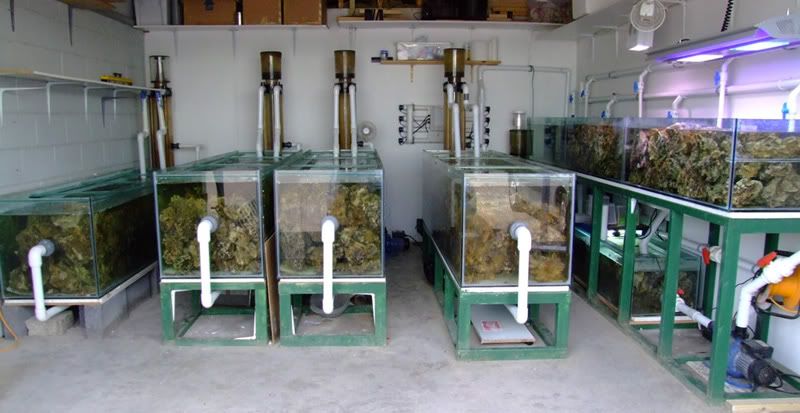Live Rock


Before the introduction of live rock in the marine aquarium hobby, it was considered difficult to keep even the hardiest of marine fish alive. This was mainly due to the poor understanding of the natural habitat and the biological processes required for the water to be habitable for aquatic life. When live rock came on the scene, it opened up whole new avenues for marine hobbyists to explore; the most note worthy being the captive care of delicate corals.
The term live rock primarily refers to the beneficial bacteria found within the pores of the rock. A more practical and wider scope definition of live rock also refers to the many different types of hitchhikers that can be found in and on the rock such as 'pods, worms, sponges, coralline algae, macro algae, snails, mini-feather dusters, and many other types of small and microscopic life forms that use the rocks for their homes as seen in the photo above. There are many different types and grades of live rock available and the more popular marine tanks become the more variety there is to chose from.
Types of Live Rock
Uncured
Uncured live rock is rock that has just been imported from the ocean and still has a lot of organic matter on it. Most of the organic matter will die off with four to six weeks This is caused by the rock being exposed to air and the vigor's of being transported half way around the world so that we can use it in the tank. Uncured live rock is mostly used in new tanks that don't have anything in it to initiate the cycling process. It cannot be added to an established system as the decaying matter will cause ammonia and nitrite spikes in the tank. When you get uncured live rock you should remove as much decaying organic matter, especially sponges, as possible to reduce the amount of decay you will get in the tank.
Cured
Cured live rock is rock that has been sitting in a tank, either in someone's home or at the LFS for long enough periods of time that all the organic matter that was on it from the ocean to die off. This can be used to set up a nearly fully cycled tank and can safely be added to an established tank. Since it takes time and space to cure the rock, it generally costs more then uncured live rock.
Base Rock
Base rock is generally rock that was once live but for some reason or other was allowed to completely die off, generally because it has been dried out for an extended period of time. It is generally used as a less expensive foundation for larger tanks and is a great way to save on costs. Although it doesn't have any immediate benefits for the tank, over time with the addition of some premium grade live rock, it too will become live, teaming with various life forms.
Aquacultured
Aquacultured live rock is one of the newer types of rock available on the market that was introduced as an alternative to taking wild harvested rock from the delicate reef systems around the world. It generally consists of Tuffa rock or aragonite rocks that have been mined on land and dumped into the ocean for a couple years to give it time for life forms, primarily bacteria, to colonize it so we can use it in our tanks. The main disadvantage to aquacultured live rock is that it generally more dense, thus heavier, then live rock that was taken from a coral reef. This means that there isn't as much surface area for the bacteria to colonize so you'll need more rock to do the same job as the more porous rocks. The second disadvantage to aquacultured live rock is that the rock doesn't contain the same biodiversity as wild harvested rock does.
Premium Grade
The highest quality live rock is commonly referred to as premium grade live rock. Occasionally you'll find some more elaborate names such as "Ultra Premium" or "Grade A" and as such you'll be paying ultra high prices for it. Having said that, if you can get this type of live rock you may want to look into getting a small quantity as it generally comes with some hidden treasures such as small corals and lots of hitchhikers (but be forewarned some of these hitchhikers aren't desirable in a reef tanks). Premium grade live rock is generally used for reef type tanks, especially since it can come with some of the most hardy corals already on it!

Curing Station Located the UK
Location, Location, Location
Along with there being so many different grades of rock, it's also worth noting that they come from many different areas and oceans as well. Some people like to have rock from a single location while others like to mix and match pieces from different locations to build intricate formations and increase the biodiversity within the tank. Rock from all the different collection points have different properties and amounts required. Here are some examples:
Fiji - This rock is fairly lightweight and porous so that you don't require as much rock as other types. It is generally recommended that you use 1 to 1.5 lb/gallon (US)
Marshall Islands - This rock is generally a very light weight porous rock. 1 to 1.5lb's per gallon is recommended for this type.
Florida - Generally is more dense then other types of live rock and comes from closer inshore. As such it is more likely to have be the home of some inter-tidal animals (mainly crabs) that require the ability to climb out of the water on occasion and can be highly predatory. Since it's 1.5 to 2 lb/gallon (US) is generally required if this is the only rock used.
Caribbean - Is generally a very dense rock. A tank requires 1.5 to 2 lb. per gallon of this type of rock.
Tonga - This comes mainly in two different varieties, branch and deepwater. Both varieties are lightweight for the size and extremely porous. The branch live rock is generally longer and narrow with interesting shapes and sizes, while the deepwater rock is more. It is also extremely porous so only 0.75 to 1.25 lb/gallon (US) is required of this rock.
Hitchhikers: The good, the bad, the often ugly
Along with knowing what type of rock available to you it's important to know some of the possible things to look for in and on live rock. These are commonly referred to as hitchhikers. Unfortunately most of these hitchhikers live within the rock and wont be readily apparent upon initial inspection. Listed below are some examples of what you may find on live rock
Click Here for more info on Hitchhickers.


Before the introduction of live rock in the marine aquarium hobby, it was considered difficult to keep even the hardiest of marine fish alive. This was mainly due to the poor understanding of the natural habitat and the biological processes required for the water to be habitable for aquatic life. When live rock came on the scene, it opened up whole new avenues for marine hobbyists to explore; the most note worthy being the captive care of delicate corals.
The term live rock primarily refers to the beneficial bacteria found within the pores of the rock. A more practical and wider scope definition of live rock also refers to the many different types of hitchhikers that can be found in and on the rock such as 'pods, worms, sponges, coralline algae, macro algae, snails, mini-feather dusters, and many other types of small and microscopic life forms that use the rocks for their homes as seen in the photo above. There are many different types and grades of live rock available and the more popular marine tanks become the more variety there is to chose from.
Types of Live Rock
Uncured
Uncured live rock is rock that has just been imported from the ocean and still has a lot of organic matter on it. Most of the organic matter will die off with four to six weeks This is caused by the rock being exposed to air and the vigor's of being transported half way around the world so that we can use it in the tank. Uncured live rock is mostly used in new tanks that don't have anything in it to initiate the cycling process. It cannot be added to an established system as the decaying matter will cause ammonia and nitrite spikes in the tank. When you get uncured live rock you should remove as much decaying organic matter, especially sponges, as possible to reduce the amount of decay you will get in the tank.
Cured
Cured live rock is rock that has been sitting in a tank, either in someone's home or at the LFS for long enough periods of time that all the organic matter that was on it from the ocean to die off. This can be used to set up a nearly fully cycled tank and can safely be added to an established tank. Since it takes time and space to cure the rock, it generally costs more then uncured live rock.
Base Rock
Base rock is generally rock that was once live but for some reason or other was allowed to completely die off, generally because it has been dried out for an extended period of time. It is generally used as a less expensive foundation for larger tanks and is a great way to save on costs. Although it doesn't have any immediate benefits for the tank, over time with the addition of some premium grade live rock, it too will become live, teaming with various life forms.
Aquacultured
Aquacultured live rock is one of the newer types of rock available on the market that was introduced as an alternative to taking wild harvested rock from the delicate reef systems around the world. It generally consists of Tuffa rock or aragonite rocks that have been mined on land and dumped into the ocean for a couple years to give it time for life forms, primarily bacteria, to colonize it so we can use it in our tanks. The main disadvantage to aquacultured live rock is that it generally more dense, thus heavier, then live rock that was taken from a coral reef. This means that there isn't as much surface area for the bacteria to colonize so you'll need more rock to do the same job as the more porous rocks. The second disadvantage to aquacultured live rock is that the rock doesn't contain the same biodiversity as wild harvested rock does.
Premium Grade
The highest quality live rock is commonly referred to as premium grade live rock. Occasionally you'll find some more elaborate names such as "Ultra Premium" or "Grade A" and as such you'll be paying ultra high prices for it. Having said that, if you can get this type of live rock you may want to look into getting a small quantity as it generally comes with some hidden treasures such as small corals and lots of hitchhikers (but be forewarned some of these hitchhikers aren't desirable in a reef tanks). Premium grade live rock is generally used for reef type tanks, especially since it can come with some of the most hardy corals already on it!

Curing Station Located the UK
Location, Location, Location
Along with there being so many different grades of rock, it's also worth noting that they come from many different areas and oceans as well. Some people like to have rock from a single location while others like to mix and match pieces from different locations to build intricate formations and increase the biodiversity within the tank. Rock from all the different collection points have different properties and amounts required. Here are some examples:
Fiji - This rock is fairly lightweight and porous so that you don't require as much rock as other types. It is generally recommended that you use 1 to 1.5 lb/gallon (US)
Marshall Islands - This rock is generally a very light weight porous rock. 1 to 1.5lb's per gallon is recommended for this type.
Florida - Generally is more dense then other types of live rock and comes from closer inshore. As such it is more likely to have be the home of some inter-tidal animals (mainly crabs) that require the ability to climb out of the water on occasion and can be highly predatory. Since it's 1.5 to 2 lb/gallon (US) is generally required if this is the only rock used.
Caribbean - Is generally a very dense rock. A tank requires 1.5 to 2 lb. per gallon of this type of rock.
Tonga - This comes mainly in two different varieties, branch and deepwater. Both varieties are lightweight for the size and extremely porous. The branch live rock is generally longer and narrow with interesting shapes and sizes, while the deepwater rock is more. It is also extremely porous so only 0.75 to 1.25 lb/gallon (US) is required of this rock.
Hitchhikers: The good, the bad, the often ugly
Along with knowing what type of rock available to you it's important to know some of the possible things to look for in and on live rock. These are commonly referred to as hitchhikers. Unfortunately most of these hitchhikers live within the rock and wont be readily apparent upon initial inspection. Listed below are some examples of what you may find on live rock
Click Here for more info on Hitchhickers.